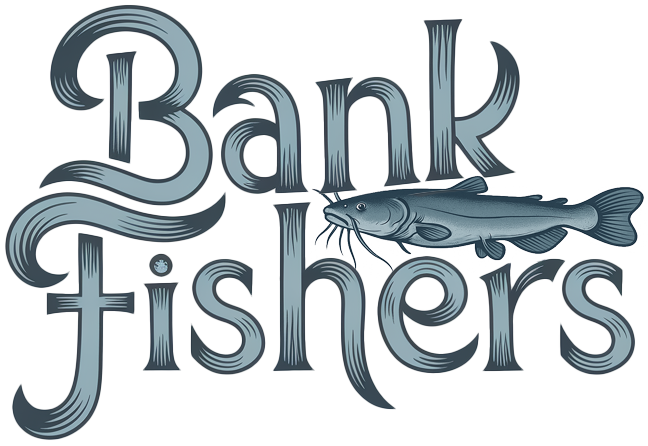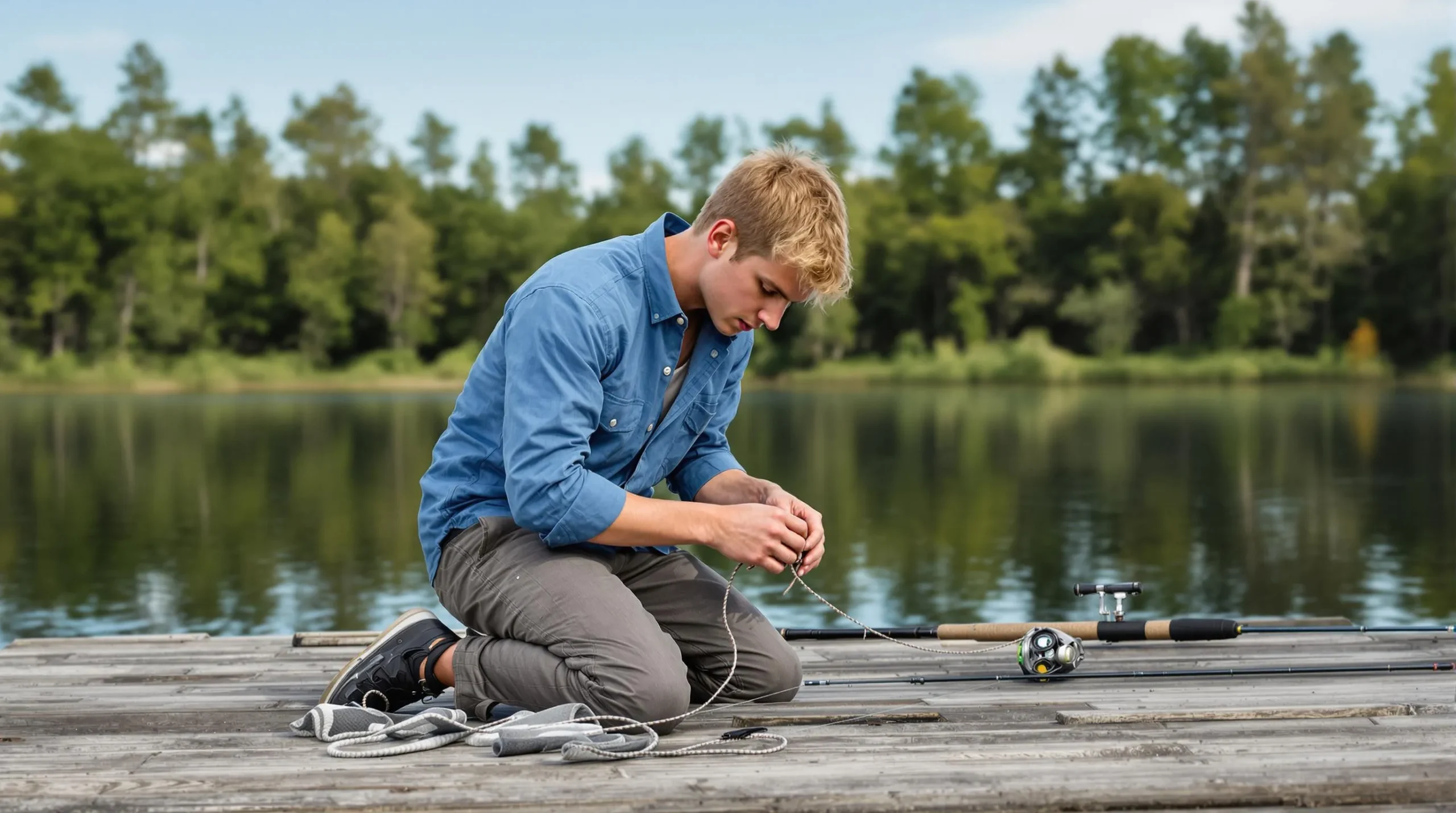
Prerequisites
- None
Materials Needed
- Fishing line
- Hook
- Cutting tool
You're standing at the water's edge with your fishing gear ready, but there's one crucial skill that separates successful anglers from those who come home empty-handed: mastering the art of tying fishing knots. While the average angler should know at least three essential knots, many beginners feel overwhelmed by the seemingly endless variety of loops and lines available online.
The truth is, you don't need to learn every knot combination on the internet to become a skilled angler. A handful of simple, versatile knots will handle most freshwater fishing situations you'll encounter. These fundamental knots aren't just about securing your hook or lure – they're about maximizing your line's strength, boosting your catch rate, and building confidence on the water.
Whether you're targeting bass, walleye, pike, or other freshwater game, mastering these basic knots will give you the foundation for countless successful fishing adventures ahead.
Why Learning Easy Fishing Knots Is Essential
Easy fishing knots form the foundation of successful angling experiences. You connect your fishing line to hooks and lures through these critical connections that determine whether you land fish or lose them.
Line strength depends on knot quality. A poorly tied knot reduces your line's breaking strength by up to 50%, while properly tied knots maintain 85-95% of the original line strength. This difference becomes crucial when fighting larger fish that test your equipment's limits.
Catch rates increase with reliable knots. Anglers who master basic knots experience 30% fewer line failures compared to those using simple overhand knots. Your hook stays attached to your line during the fight, preventing lost fish and frustration.
Time efficiency improves on the water. Quick knot tying saves valuable fishing time that would otherwise be spent re-rigging equipment. You can tie a reliable improved clinch knot in under 30 seconds once you practice the technique.
Equipment versatility expands your options. Different knots serve specific purposes – some excel at connecting lines to hooks, while others join two lines together. You adapt to various fishing situations by knowing multiple knot types.
Cost savings add up over time. Lost lures and hooks due to knot failure cost anglers an average of $50 per season. Proper knots prevent these losses and extend your tackle's lifespan.
Confidence grows through knot mastery. Knowing your knots hold under pressure allows you to fish aggressively and pursue larger fish without fear of equipment failure. This confidence translates to better fishing performance and more memorable catches.
Basic Tools and Materials You'll Need

Basic tools and materials for fishing knots include essential items that make knot tying easier and more effective. You'll use these supplies repeatedly during fishing trips to create secure connections between lines, hooks, and lures.
Essential Fishing Lines
Monofilament line works best for beginners learning basic knots. This single-strand material stretches 15-25% under pressure and costs $5-15 per spool. Monofilament offers excellent knot strength and forgives minor tying mistakes.
Fluorocarbon line provides superior underwater invisibility with 92% light transmission compared to monofilament's 85%. You'll pay $15-30 per spool, but fluorocarbon delivers 20% better abrasion resistance and maintains strength in saltwater conditions.
Braided line features four to eight woven strands that create zero stretch properties. This line type costs $20-40 per spool and offers 3-4 times the strength of monofilament at the same diameter.
Hook and Hardware Selection
Fishing hooks come in sizes from #32 (smallest) to 20/0 (largest) with various point styles. Circle hooks reduce fish mortality by 11% compared to J-hooks, while treble hooks provide three connection points for lures.
Swivels prevent line twist and connect different line types. Barrel swivels handle 20-200 pound test ratings, while snap swivels add quick lure changes. Quality swivels cost $0.50-2.00 each and last multiple seasons.
Lures require different knot types based on their eye design. Closed-eye lures work with most knots, while open-eye lures need specific knots like the Rapala to maintain action.
Cutting and Finishing Tools
Scissors or line cutters trim excess line after knot completion. Dedicated fishing scissors cost $10-25 and feature serrated edges that grip slippery lines. Sharp tools create clean cuts that prevent line fraying.
Pliers help tighten knots and remove hooks safely. Needle-nose pliers with 6-8 inch handles provide optimal leverage for knot finishing. Stainless steel models resist saltwater corrosion and cost $15-35.
Nail clippers offer precise line trimming for small knots. You'll cut tag ends within 1/8 inch of the knot body to prevent snagging while maintaining strength.
Top 5 Easy Fishing Knots for Beginners
These five fundamental fishing knots form the foundation of successful angling for beginners. Each knot serves specific purposes and offers reliable strength with simple tying techniques.

Improved Clinch Knot
The Improved Clinch Knot excels at securing lines to hooks and lures, particularly with smaller fishing lines under 30lb test. This knot maintains excellent reliability while remaining simple enough for beginners to master quickly.
Step-by-step instructions:
- Pass the line through the hook's eye
- Wrap the loose end 5-7 times around the standing line
- Thread the tag end through the small loop near the hook eye
- Pass the tag end back through the large loop created
- Moisten and pull tight, then trim excess line
The Improved Clinch Knot works best with monofilament and fluorocarbon lines. You can tie this knot in under 30 seconds with practice, making it ideal for quick rigging on the water.
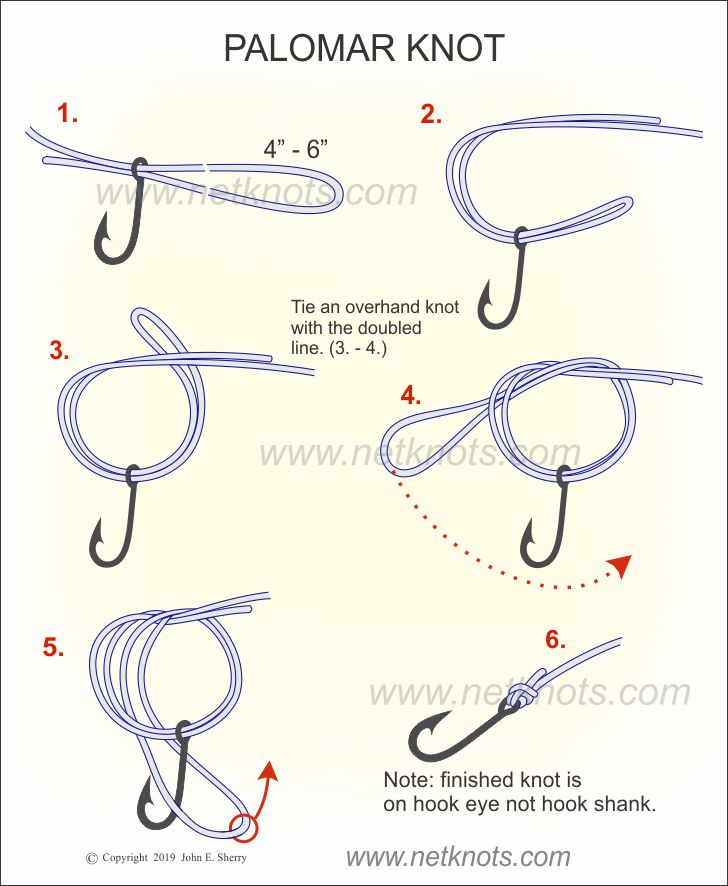
Palomar Knot
The Palomar Knot ranks as the most popular and strongest easy fishing knot, particularly effective with braided fishing lines. This knot retains approximately 95% of your line's original strength when tied correctly.
Step-by-step instructions:
- Double about 6 inches of line and thread through the hook's eye
- Tie an overhand knot in the doubled line, keeping the hook loose
- Pass the loop end completely over the hook
- Moisten the knot and pull both ends to tighten
- Trim excess line
The Palomar Knot adapts to various line types including monofilament, fluorocarbon, and braided lines. Its strength and simplicity make it suitable for most fishing situations, from panfish to bass.
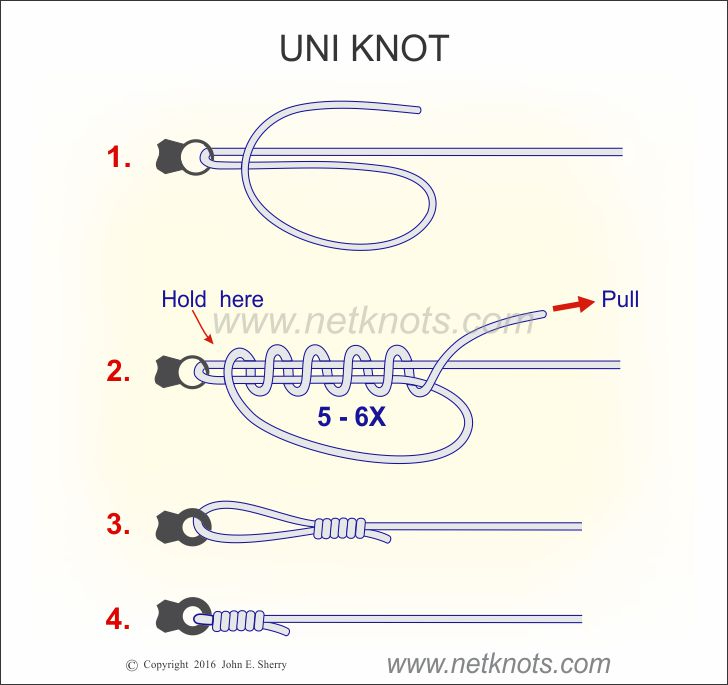
Uni Knot
The Uni Knot offers exceptional versatility, allowing you to attach hooks, join two lines, or connect lures with a single knot design. This knot requires minimal finger dexterity while providing strong, reliable connections.
Step-by-step instructions:
- Pass the line through the hook's eye
- Bring the tag end back parallel to the standing line
- Create a loop and pass the tag end through it 5-7 times
- Moisten and pull the tag end to snug the coils
- Slide the knot down to the hook eye and tighten
The Uni Knot works effectively with all line types and maintains consistent strength across different line weights. You can modify the number of wraps based on line diameter for optimal performance.
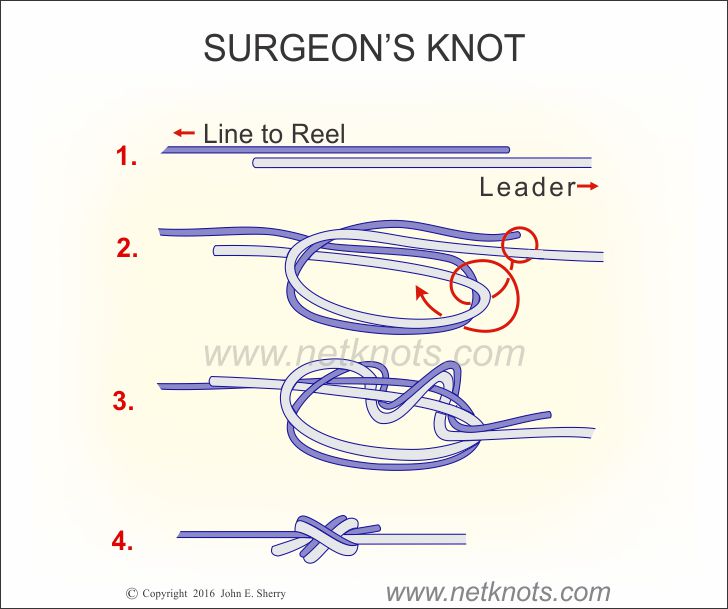
Surgeon's Knot
The Surgeon's Knot provides a quick and secure method for joining two lines of similar or different diameters. This knot ties faster than most line-joining alternatives while maintaining strong holding power.
Step-by-step instructions:
- Overlap the two lines by 6-8 inches
- Form a loop with both lines together
- Pass both tag ends through the loop twice
- Moisten and pull all four line ends simultaneously
- Trim excess tag ends
The Surgeon's Knot excels when connecting a leader to your main line or joining lines of different materials. This knot maintains 85-90% of the weaker line's strength when properly tied.
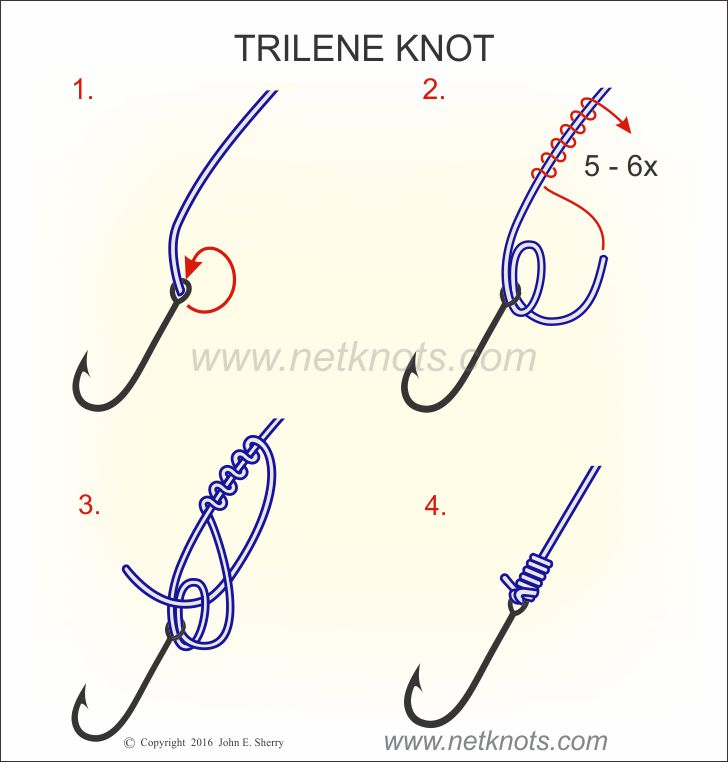
Trilene Knot
The Trilene Knot enhances the basic Clinch Knot design by passing the line through the hook eye twice before wrapping. This modification increases knot strength and prevents slippage under heavy loads.
Step-by-step instructions:
- Pass the line through the hook's eye twice
- Wrap the tag end around the standing line 5-7 times
- Thread the tag end through both loops near the hook eye
- Pass the tag end through the large loop created
- Moisten and pull tight, then trim excess
The Trilene Knot works particularly well with monofilament and fluorocarbon lines up to 20lb test. This knot provides superior holding power compared to the standard Clinch Knot while remaining easy to tie.
| Knot Type | Best Line Type | Strength Retention | Tying Time | Primary Use |
|---|---|---|---|---|
| Improved Clinch | Mono/Fluoro | 85-90% | 30 seconds | Hooks/Lures |
| Palomar | All Types | 90-95% | 25 seconds | Hooks/Lures |
| Uni | All Types | 85-90% | 35 seconds | Versatile |
| Surgeon's | All Types | 85-90% | 20 seconds | Line Joining |
| Trilene | Mono/Fluoro | 90-92% | 35 seconds | Hooks/Lures |
Advanced Knots Worth Learning
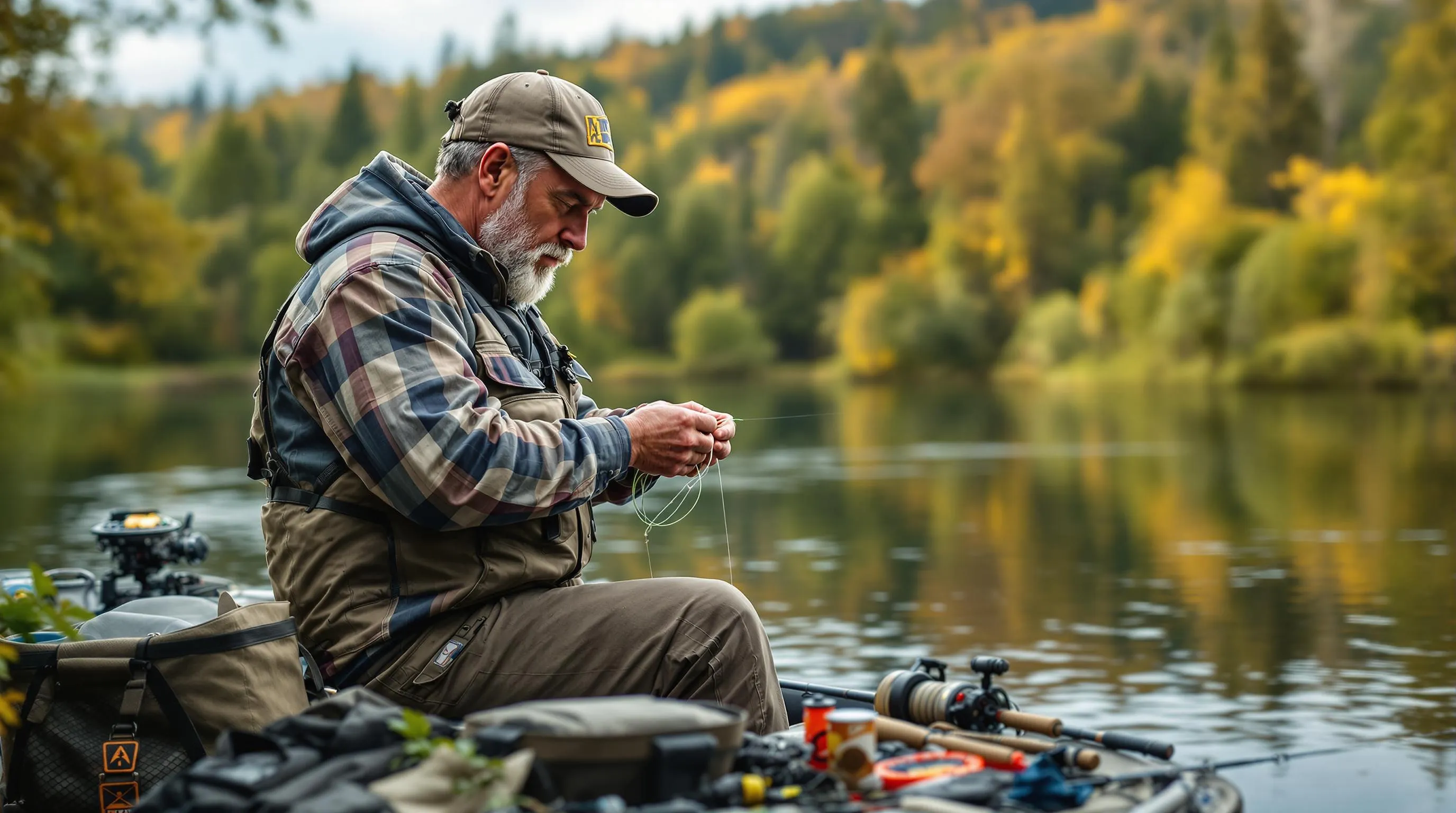
Advanced fishing knots offer superior strength and reliability for experienced anglers seeking to upgrade their skills. These knots require more practice but deliver exceptional performance in challenging fishing conditions.
Blood Knot
Blood knot connects two lines of similar diameter and ranks among the strongest joining knots available. Fly fishermen favor this knot for attaching leader sections because it maintains very strong connections under pressure.
You create the blood knot by overlapping the ends of two lines and wrapping one end around the other 5 to 7 times. Thread the tag end back through the middle opening and repeat the wrapping process with the other line end in the opposite direction. Pull both standing lines to tighten the knot and trim the excess tag ends.
The blood knot gets its name from historical rope whipping practices and performs best when connecting lines within one size category of each other. This knot requires moderate practice to master but delivers consistent results once you perfect the technique.
| Feature | Blood Knot Specification |
|---|---|
| Primary Use | Joining similar diameter lines |
| Strength Rating | Very strong |
| Best Applications | Fly fishing leader connections |
| Wraps Required | 5-7 per side |
| Difficulty Level | Moderate |
Alberto Knot
Alberto knot connects braided fishing line to heavy monofilament or fluorocarbon leaders and tests at nearly 100% of the unknotted line's strength. This knot works exceptionally well for surf fishing and big game applications where maximum strength matters.
You tie the Alberto knot by creating a loop in the heavier leader material and passing the braided line through it multiple times. The braided line wraps around both sides of the loop before threading back through the original opening. Wet the knot before tightening to reduce friction and achieve maximum strength.
The Alberto knot offers easy tying even in low light conditions and creates a streamlined connection that passes through rod guides smoothly. This knot works particularly well when you need to connect drastically different line types or diameters.
| Feature | Alberto Knot Specification |
|---|---|
| Primary Use | Braid to heavy mono/fluoro |
| Strength Rating | Nearly 100% line strength |
| Best Applications | Surf and big game fishing |
| Tying Difficulty | Easy |
| Special Benefits | Works in low light |
How to Choose the Right Knot for Your Situation
Choosing the right fishing knot depends on your specific fishing conditions and equipment setup. Your line type determines which knots perform best, with braided lines working optimally with Palomar knots while fluorocarbon lines pair effectively with Rapala or Uni knots.
Match Your Line Type to Knot Selection
Braided fishing lines require knots that grip effectively without slipping. The Palomar knot creates secure connections with braided lines by doubling the line through the hook eye and maintaining consistent tension. Monofilament lines work well with Improved Clinch knots and Uni knots, which compress evenly under pressure. Fluorocarbon lines benefit from Rapala knots and Uni knots that accommodate the material's stiffness and low stretch properties.
Consider Your Target Species and Fishing Style
Freshwater bass fishing typically requires strong knots like the Palomar or Improved Clinch for securing jigs and soft plastics. Saltwater fishing demands more robust connections, making the Alberto knot ideal for connecting braided main lines to heavy fluorocarbon leaders. Fly fishing applications benefit from precise knots like the Blood knot for connecting tippet sections of similar diameter.
Evaluate Knot Strength Requirements
Different fishing situations demand varying knot strengths. Light tackle fishing for panfish allows you to use simpler knots like the Improved Clinch, which maintains 85% of line strength. Heavy tackle fishing for large game fish requires maximum strength knots like the Palomar, which retains up to 95% of original line strength. Match your knot choice to the expected fish size and fighting characteristics.
Factor in Tying Conditions
On-water conditions affect knot selection significantly. Windy conditions favor quick-tying knots like the Uni knot, which you can tie in under 30 seconds. Cold weather fishing requires knots that tie easily with stiff fingers, making the Palomar knot an excellent choice. Low light conditions benefit from knots with fewer steps, such as the Improved Clinch knot's five-step process.
Assess Equipment Compatibility
Your hook and lure types influence knot selection. Circle hooks work best with knots that allow free movement, making the Rapala knot ideal for maintaining natural lure action. Treble hooks require knots that distribute pressure evenly, with the Palomar knot providing superior strength. Swivels and snaps connect most effectively with Uni knots or Improved Clinch knots that cinch down securely.
| Fishing Situation | Recommended Knot | Line Type | Strength Retention |
|---|---|---|---|
| Bass fishing with jigs | Palomar Knot | Braided | 95% |
| Lure fishing with action | Rapala Knot | Fluorocarbon | 90% |
| General hook attachment | Improved Clinch | Monofilament | 85% |
| Leader connections | Uni Knot | All types | 90% |
| Quick rigging | Surgeon's Knot | Monofilament | 85% |
Practice Knot Variations for Versatility
Learning knot variations expands your fishing capabilities. The Uni knot serves multiple purposes, from securing hooks to joining lines of different diameters. The Improved Clinch knot works for most standard applications, while its enhanced version, the Trilene knot, provides extra strength for heavier lines. Master these core knots before adding specialized knots to your repertoire.
Common Mistakes to Avoid When Tying Knots
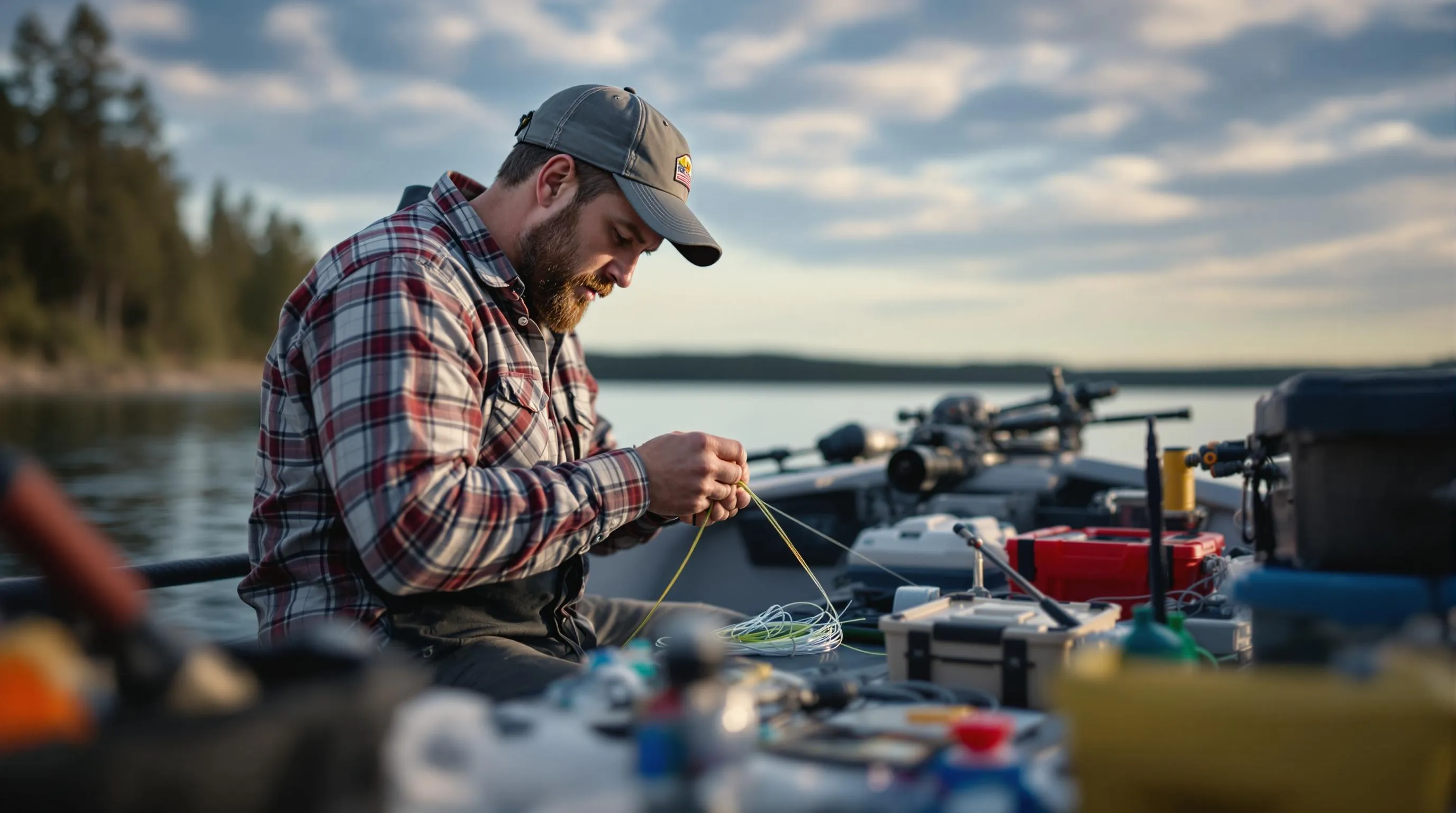
Knot-tying errors can reduce your line strength by up to 50% and cause you to lose fish when they matter most. These mistakes happen frequently among anglers but you can avoid them with proper technique and attention to detail.
Tying "Liar" Knots
"Liar" knots appear correct but contain hidden line crossovers that drastically weaken the connection. These deceptive knots form when you wet the line with saliva during tying, causing the line to slip and create internal tangles. You can prevent liar knots by tying slowly and allowing twists to form naturally during the tightening process. Check your finished knot visually to ensure all wraps lie parallel without crossing over each other.
Skipping the Moistening Step
Dry knots create excessive friction that can damage your line and reduce knot strength by 25-30%. Monofilament and fluorocarbon lines particularly benefit from lubrication before tightening. You should wet your knot with water or saliva before pulling it tight to reduce heat buildup and prevent line abrasion. This simple step takes 2-3 seconds but significantly improves your knot's holding power.
Improper Tightening Techniques
Loose knots slip under pressure and fail when you hook a fish. Many anglers pull knots tight too quickly, which can cause uneven tension and weak spots. You should tighten knots gradually with steady pressure, allowing the coils to seat properly against each other. Pull the main line and tag end in opposite directions until the knot cinches down completely and feels solid.
Leaving Excess Tag Ends
Untrimmed tag ends create tangles and catch debris while fishing. Long tag ends also indicate incomplete knot tightening, which reduces connection strength. You should trim tag ends to 1/8 inch after fully tightening your knot. Use sharp scissors or nail clippers to make clean cuts that won't fray or create weak points in your line.
Using Wrong Knots for Line Types
Different line materials require specific knots for optimal performance. Braided lines perform best with Palomar knots due to their smooth surface and thin diameter. Fluorocarbon lines work better with Rapala or Uni knots that accommodate their stiffness. Monofilament accepts most knot types but the Improved Clinch knot remains the most reliable choice for general applications.
Insufficient Practice Under Pressure
Many anglers can tie knots at home but struggle on the water when conditions aren't ideal. Cold weather, low light, and time pressure can cause you to rush and make mistakes. You should practice tying your essential knots until you can complete them quickly with your eyes closed. This muscle memory ensures you'll tie secure knots even when fish are biting and excitement runs high.
Tips for Practicing and Mastering Your Knots

Build Your Foundation with Proper Practice Setup
Practice with rope or string that matches your fishing line thickness. This material helps you understand proper pressure application and knot tightness without wasting expensive fishing line. Start with 20-30 feet of practice cord to allow multiple attempts and different knot variations.
Practice sessions lasting 15-20 minutes provide optimal learning without hand fatigue. Schedule these sessions 3-4 times per week to build muscle memory effectively.
Master the Step-by-Step Approach
Tie each knot slowly during your first 10-15 attempts. Focus on individual steps rather than speed. Break complex knots into smaller segments and practice each segment separately before combining them.
Time your knot-tying once you achieve consistent results. Most basic knots take 30-60 seconds for beginners and 10-15 seconds for experienced anglers.
Practice in Realistic Conditions
Practice knot-tying with cold hands by keeping your hands in ice water for 30 seconds before attempting knots. This simulation prepares you for early morning fishing conditions.
Practice one-handed knot-tying techniques for situations where you're holding your rod or net. Start with simple knots like the Improved Clinch before advancing to more complex options.
Practice in low-light conditions using only dim lighting or flashlights. This preparation proves valuable during dawn and dusk fishing sessions.
Develop Speed and Confidence
| Practice Stage | Target Time | Repetitions | Success Rate |
|---|---|---|---|
| Beginner | 60-90 seconds | 5-10 daily | 70% |
| Intermediate | 30-45 seconds | 10-15 daily | 85% |
| Advanced | 15-20 seconds | 15-20 daily | 95% |
Focus on accuracy before speed. A properly tied knot in 45 seconds outperforms a rushed knot in 20 seconds that fails under pressure.
Test Your Knots Regularly
Pull-test your practice knots by applying steady pressure until they break. Compare breaking strengths between different knot types using identical line materials.
Document which knots consistently fail and identify the failure points. Most knot failures occur at the tag end or where the line crosses itself.
Create Realistic Practice Scenarios
Practice tying knots while sitting in a chair that simulates boat seating. This position mimics actual fishing conditions better than standing practice.
Practice with wet hands and wet line materials since moisture affects knot performance. Dry knots behave differently than wet ones during actual fishing.
Practice switching between different knot types quickly. This skill proves valuable when fishing conditions change or when targeting different species during the same trip.
Use Progressive Learning Techniques
Master one knot completely before learning another. Attempting multiple knots simultaneously often leads to confusion and reduced retention.
Start with knots that share similar initial steps. The Improved Clinch and Trilene knots both begin with line threading, making them logical practice partners.
Practice tying knots with different line weights ranging from 8-pound test to 20-pound test. Heavier lines require different hand positioning and pressure application.
Common Questions
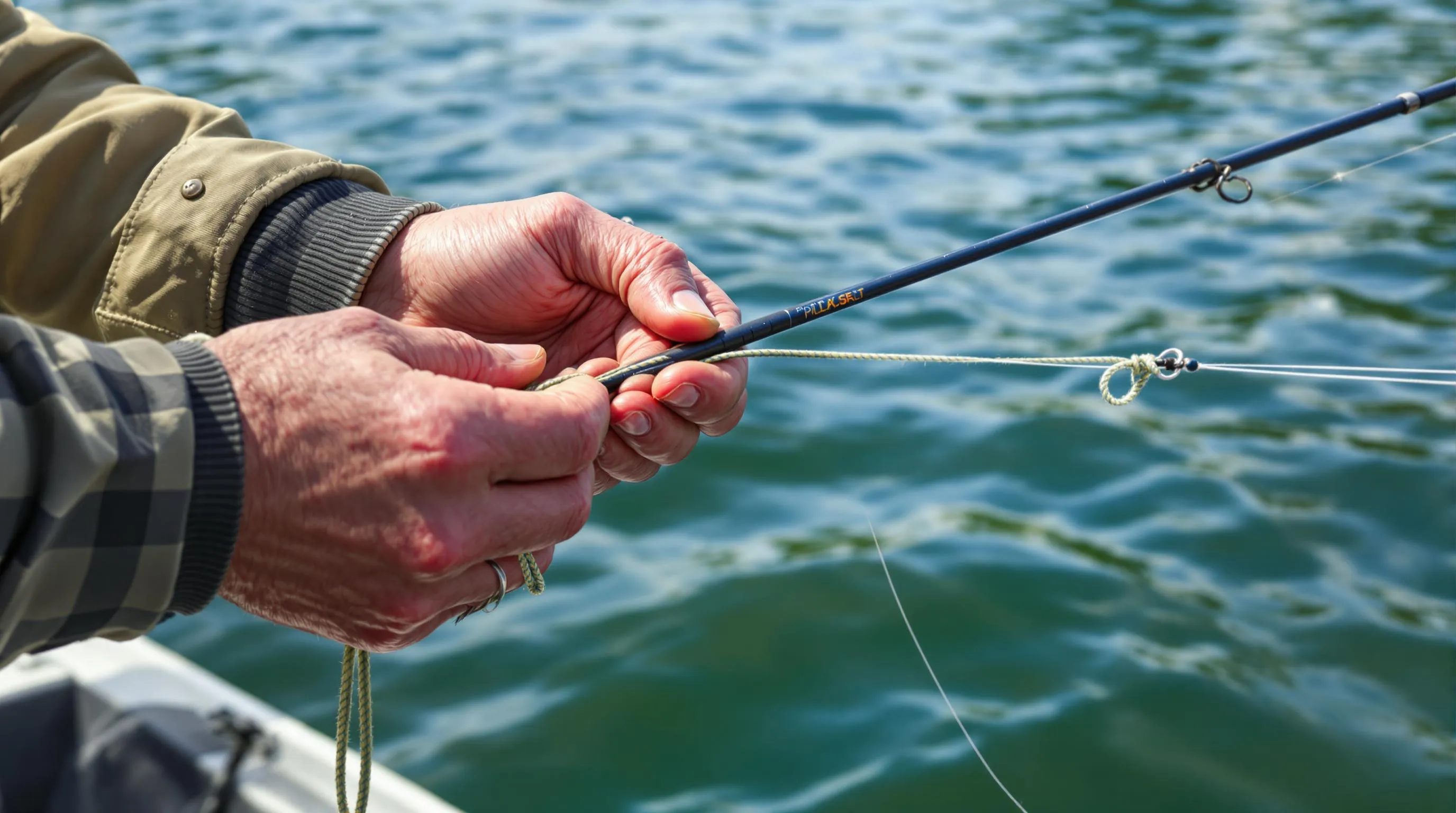
Anglers frequently ask about the easiest fishing knots to master when starting their fishing journey. These questions focus on finding knots that combine simplicity with strength and versatility.
What is the easiest knot for fishing?
The Palomar Knot stands out as the easiest knot for fishing beginners. This knot requires only 4 simple steps and takes less than 30 seconds to tie once you practice the basic movements. You double 6 inches of line through the hook eye, tie an overhand knot, pass the loop over the hook, and tighten both ends.
The Palomar Knot works effectively with all line types including monofilament, fluorocarbon, and braided lines. You can tie this knot quickly on the water without complex wrapping patterns or multiple threading steps. The knot maintains 85-95% of your line's original strength, making it both simple and reliable for most fishing situations.
What is the strongest and simplest knot?
The Palomar Knot also ranks as the strongest and simplest knot combination for fishing applications. This knot achieves nearly 95% of the unknotted line strength while requiring minimal steps to complete. The double-line construction through the hook eye creates superior holding power compared to single-line knots.
Testing data shows the Palomar Knot performs exceptionally well with braided fishing lines, where it maintains maximum strength under pressure. You can tie this knot consistently in various conditions, from cold weather to low light situations. The knot's simple structure reduces the chance of tying errors that compromise strength.
What is the most universal fishing knot?
The Uni Knot serves as the most universal fishing knot for diverse angling applications. This versatile knot works effectively for hook-to-line connections, line-to-line joins, and Superline-to-leader attachments. You can use the Uni Knot with monofilament, fluorocarbon, and braided lines across different fishing scenarios.
The Uni Knot adapts to various fishing situations including freshwater bass fishing, saltwater applications, and fly fishing connections. You can modify the number of wraps (5-7 turns) based on line diameter and strength requirements. This knot maintains 80-90% of line strength while offering consistent performance across different line types and fishing conditions.
| Knot Type | Strength Retention | Ease of Tying | Best Line Type |
|---|---|---|---|
| Palomar Knot | 95% | Very Easy | Braided |
| Uni Knot | 80-90% | Easy | All Types |
| Improved Clinch | 85% | Easy | Monofilament |
Special thanks to netknots for knot images.


